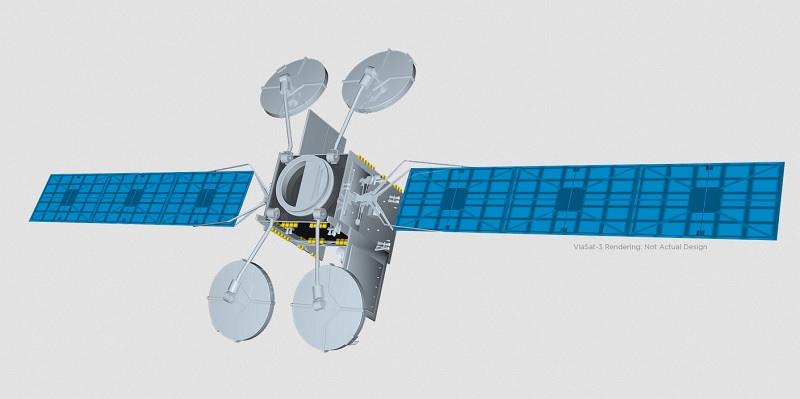
A Viasat image of its ViaSat 3 satellite, slated to launch before 2022
WASHINGTON: A new survey of more than 300 active military and senior DoD civilians shows widespread dissatisfaction with both the reliability and capabilities of military communications networks, with 98 percent of respondents saying they’ve experienced black outs in connectivity at some point during a critical operation.
The poll, conducted between August and September 2019 by the Government Business Council (the research arm of Government Executive Media Group) found that “warfighters do not have the levels of connectivity they need,” according to the findings released today at the Association of the U.S. Army (AUSA) annual convention. “The State of Military Communications Technologies” survey was co-sponsored by Viasat, a commercial provider of broadband satellite communications including to the US military. For example, Viasat provides Air Force and Navy aircraft with the Joint Tactical Radio System (JTRS) Multifunctional Information Distribution System (MIDS) radios. Viasat operates four satellites in Geosynchronous Orbit (GEO), and plans to launch its fifth, the upgraded ViaSat 3, on a SpaceX Falcon Heavy sometime by 2022.
Viasat President Ken Peterman told reporters on Friday that the survey, which targeted milcom professionals, was designed to raise awareness about the scale and scope of the current problems with out-of-date, and unreliable military communications systems. “Technical leadership is in the private sector now,” he said, and DoD has simply been unable to keep up.
Those polled said that resiliency and cyber protection are the two most valued requirements for future milcom systems. The survey also found that there is widespread agreement that the current acquisition systems in place across the Air Force, Army, Navy and DoD are too creaky to provide the most modern technologies in a timely manner.
Also, Peterman said, the acquisition models used for terminals — that put a premium on ensuring that identical terminals are fielded in massive numbers over several years — is too rigid to allow for the rolling updates used by commercial technology providers.
Viasat was one of the companies heavily involved in the run-up to Gen. Jay Raymond’s initiative at Air Force Space Command to create a new “Vision for Satellite Communications.” The vision document, as Breaking D readers know is now on Raymond’s desk for review, lays out a blueprint for a satcom network that meshes commercial and military satellites into a seamless web, using terminals and receivers that can “hop” multiple satellites and signals just like a cell phone automatically “roams” among connected networks and cell towers.
Viasat — like its contemporaries in the field including Hughes, Intelsat, Inmarsat, SES and Eutelsat — have been pushing DoD to move towards buying so-called “managed services” (kinda like your average mobile phone or cable TV/Internet plan) rather than leasing commercial bandwidth in fits and starts for short periods of time.
There has been interest from DoD in the concept, with some 60 percent of survey respondents agreeing that “increasing the use of commercial solutions would speed up the current pace of defense acquisitions.”
However, up to now, moving in that direction has proven nigh on impossible, leading to frustrations within the commercial satcom community as well as among military user groups. “It’s not where we want it to be,” one senior comsat official told Breaking D.
This is despite the fact that during a recent conference on satellite innovation held in Silicon Valley, Northern Sky Research predicted that investments by commercial industry in LEO constellations could exceed $37 billion over the next 5 to 10 years. “The DoD may be better served leveraging this investment than creating its own constellation,” stated another industry source.
Lucy Bierer, of the Government Business Council, said only 27 percent of respondents believe that DoD’s budget priorities for communications tech allow their organizations to keep up with adversary threats. She aded that some 63 percent said that US communications technologies are either “on par or falling behind” the capabilities of adversaries.
Air Force picks Anduril, General Atomics for next round of CCA work
The two vendors emerged successful from an original pool of five and are expected to carry their drone designs through a prototyping phase that will build and test aircraft.



























